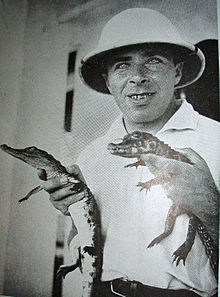Jiří Baum
Jiří Baum (born September 20, 1900 in Prague , † 1944 in Warsaw ) was a Czech zoologist , globetrotter and writer . During the Second World War he was involved in the Czech resistance against the Nazis.
Life
Jiří Baum was born in Prague. He grew up in a time when the technology and social and economic movements of the beginning of the 20th century were changing the world like never before. This time also made it possible to travel with new means of transport, which made it possible to explore previously undiscovered areas.
Baum was interested in nature and traveling from childhood. At the request of his parents, he also studied at the business academy. The only thing he kept from it later was his knowledge of shorthand and typing. He continued his studies at the Faculty of Science at Charles University and graduated in 1928 with a doctorate .
In the meantime he began his travels. After exploring Germany for the first time, he took his first long trip to the USA with his friend Viktor Mayer in 1921 . She first explored the New World by bicycle, but it soon became apparent that the journey on foot and as a hitchhiker would get her ahead faster. In the end, they even made money for an old Ford . The yield of the trip was a collection of photographs.
Viktor Mayer went on to South America and Braun returned home. A year later he and his sister visited friend Viktor in Brazil . They traveled the country and tried their hand at farmers . This attempt failed, perhaps also because a revolt broke out in this region at that time . Braun and his sister returned to Prague and he continued his studies. He specialized in arachnology .
While still a student, he visited West Africa with the botanist Albert Pilát . He made a few trips inland, where he put on numerous collections. In the process, he contracted malaria .
He learned Malay and later translated from this language as well. In 1928 he visited Malaysia and surrounding countries. He also took part in an ornithological congress on Java .
In the following time he concentrated on Africa. In 1930 he traveled to Tunisia and Algeria together with the zoologists of the national museum Josef Mařan, Jan Obenberger, Karel Táborský and Václav Jan Staněk . At this time, the free collaboration with the museum began. He collected material on his travels - also at the request of the scientists - and left it to the institute.
A year later he visited Africa again, one of his most demanding trips. Together with the owner of the truck manufacturer TATRA and the sculptor František Vladimír Foit, he traveled through Africa from north to south. The journey began in Alexandria via Cairo , further along the Nile and Egypt to Sudan , Chartun, Stanleyville in the Belgian Congo , to Lake Albert in Uganda , on to Nairobi in Kenya . Here they tried to climb Kilimanjaro and came up to 5,500 meters. Via Tanzania and Rhodesia it went to the Victoria Falls , and finally they landed in Cape Town in what was then the South African Union .
From 1933 Baum traveled with his wife Růžena, whom he met in the Spanish club. Their first trip then also took them to Spain , which, like all other trips, they undertook with a robust Tatra truck. Meanwhile, Baum was already planning his trip around the world.
It started in Australia and took him from Perth in the west to Adelaide , Melbourne , Sydney and Brisbane . From Australia it went via the Philippines to Japan and then to the USA. During the entire trip he also made the Czech Republic known. He always carried two large boxes of slides with him, which he used in his lectures on the Czech Republic.
His last trip in 1938 took him to East Africa , where he mainly visited national parks . Then we went back to South and South West Africa . On this trip he received news of the occupation of his homeland by the German Nazis . He had the option to stay abroad but decided to fight for the freedom of his country. So he returned to the Czech Republic and joined the resistance workers there.
They distributed leaflets, gave shelter, took photos and documented. After the group fell apart, Baum was not betrayed, but arrested in 1943 and, because of his Jewish origins, first deported to the Theresienstadt concentration camp , then to the Auschwitz concentration camp and finally to the Warsaw ghetto , where he died about a year later.
However, its collections have been preserved in the National Museum and the University. His books (travelogues, science fiction books for young people, zoological treatises and stories) appeared in some editions in the 1930s and after the war. His photographic work is exhibited in the National Museum.
Web links
- Literature by and about Jiří Baum in the catalog of the German National Library
- Literature and other media by and about Jiří Baum in the catalog of the National Library of the Czech Republic
- Photographs Dr. J. Baum
- Report by Jiri Baum about the first zeppelin flight over Cairo (Source: German Embassy)
Individual evidence
- ↑ Czechs on the move: Representations of the non-European world and national identity in East Central Europe 1890–1938 . Vandenhoeck & Ruprecht 2018, page 299
| personal data | |
|---|---|
| SURNAME | Baum, Jiří |
| ALTERNATIVE NAMES | Baum, Georg |
| BRIEF DESCRIPTION | Czech zoologist, globetrotter and writer |
| DATE OF BIRTH | 20th September 1900 |
| PLACE OF BIRTH | Prague |
| DATE OF DEATH | 1944 |
| Place of death | Warsaw |
